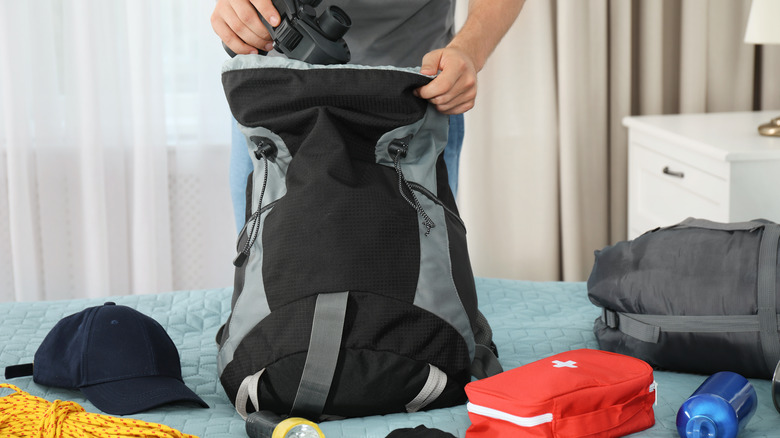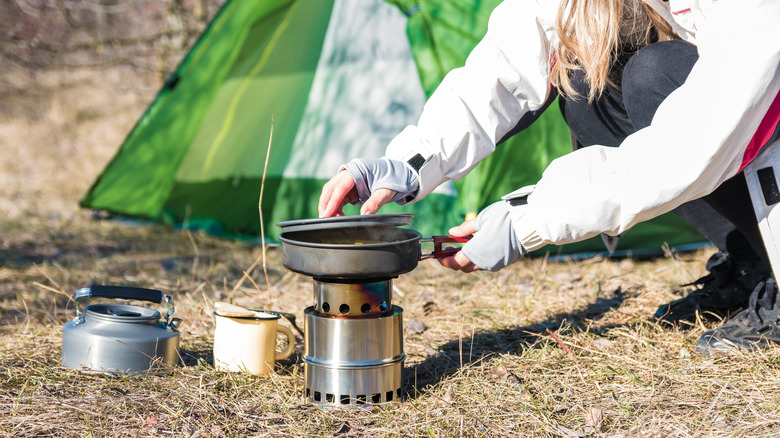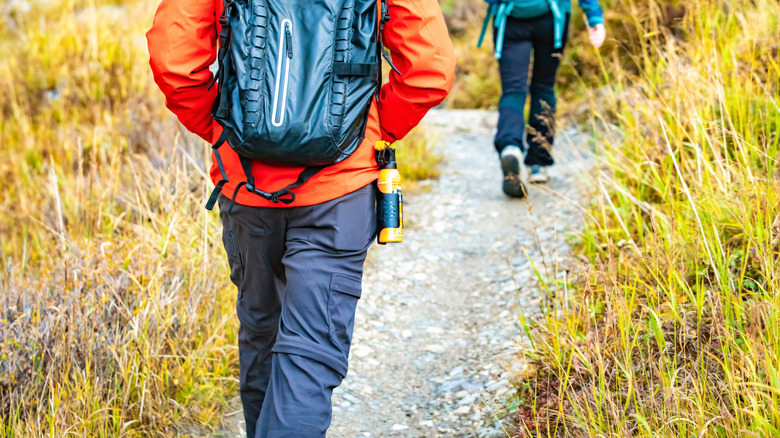The Most Common Camping Essentials That TSA Will Throw Away
Going on a camping trip can be a wonderful experience, spending time outside in the fresh air and enjoying the benefits of being in nature. Of course, packing the right equipment can affect the success of the trip, as you consider how you'll prepare your food, where you'll sleep, and what the environment will be like. It's a good idea to organize all your gear well in advance of your departure, and you might even consider practicing setting up camp before your trip to ensure that all the equipment you need will be with you when you get to your destination. If you're traveling by plane, however, it's best to know in advance what the rules are about taking camping gear onto a flight. Don't run the risk of watching an essential piece of gear get confiscated by TSA before your trip even begins (which is why it's best to leave that stove fuel and bear spray at home).
No one wants to arrive at a campsite unprepared, and it's equally upsetting to arrive at the airport and see an important item removed from your luggage because it didn't meet TSA guidelines. The best way to ensure that you have a successful trip is to learn what pieces of camping equipment you can take on the plane and which ones you need to wait to purchase after you've landed. Here are a few of the items that are commonly found at a campsite but shouldn't be taken through airport security.
Types of cooking and sleeping gear that are restricted
Every so often, TSA will publish a list of some unusual items that have been discovered and removed from travelers' luggage. While you may be curious to know what TSA does with confiscated items, it's preferable to avoid this scenario during your own trip. For example, you can pack a camp stove in your carry-on or a checked bag, but it cannot be attached to a source of fuel, and all traces of fuel or vapors must be already removed. Any type of fuel canister is prohibited in either a carry-on or a checked bag. You can bring your favorite cast-iron skillet to prepare your meals, but it must be in your checked luggage.
Certain items that could be considered a weapon, such as hiking poles, walking sticks, or canoe paddles must also be checked. Hatchets and sharp knives, while useful on the trail, cannot be brought in a carry-on but are generally allowed in checked luggage. Tent stakes also fall into this category of potential weapons and can only be packed in checked baggage. However, you have the option of carrying the actual tent and tent poles in your carry-on or your checked bag. These items will be subject to space limitations if you place them in an overhead bin, and the same rules apply to an air mattress with a built-in pump. It is allowed in your carry-on, but it must meet the cabin's weight and size limitations.
Wildlife management items that are prohibited
Other camping items are a safety risk on a flight because they are flammable or could be used to incapacitate another person. One item is bug repellent. If it is 3.4 ounces or less, it can be packed in a carry-on, and a larger container may be stowed in your checked luggage. This is welcome news because bugs at a campsite are no fun. However, an additional rule that applies to insect repellent is that it must be the type that is applied to your skin. Any type of repellent that is meant to be sprayed in the air or directly at insects is not allowed in your carry-on or your checked bag.
Another type of repellent that is often brought on camping trips is bear spray. It may come in handy if you face a grizzly on the trail (and these tips for packing food safely when you're camping in bear country can also be helpful). However, this spray is not allowed in your carry-on or your checked bag. It is considered by the FAA to be similar to pepper spray, which is not allowed on a flight either. If the chemicals in these types of sprays were to leak and circulate throughout the plane, it could be very dangerous to the passengers as well as the crew. This is the type of item to purchase after you've landed, because the good news is that you're unlikely to face an actual bear on the plane.


